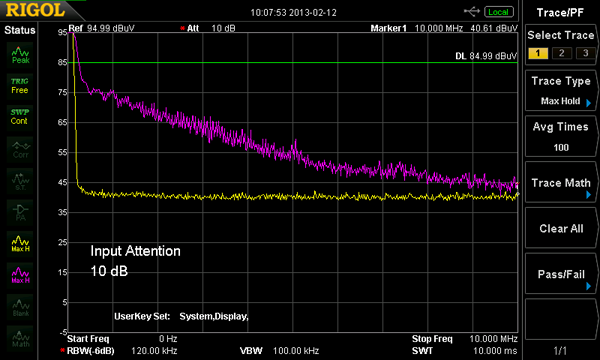Kenneth Wyatt
EDN
These unusual EMI sources may be used to perform pre-compliance testing (radiated or conducted immunity) to help determine the immunity characteristics of your circuits or product.
Chattering Relay (120 VAC powered) - can produce strong broadband emissions all the way out to at least 1 GHz.
Chattering relays are actually specified in some standards, such as SAE J1113-12 (vehicular EMC) and DO-160 (for aircraft). You can make your own quite easily with a 120 VAC or 12/24 VDC relay with heavy duty contacts. The voltage can be anything, but normally is whatever is used to power the EUT. I purchased a 120 VAC and 12 VDC relay from Radio Shack - both manufactured by Tyco Electronics. I also bought a socket that fits either, so that they may be easily replaced, once worn out.
The idea behind chattering relays is to wire the coil through one of the NC relay contacts, such that the relay is actuated momentarily until the contact opens, whereupon, it closes again, repeating the process. You'll discover why it's called a "chattering relay" once you apply power to it!
The inductance of the coil and the repeated opening and closing of the arcing contacts can create a tremendous amount of EMI, which may be inductively or capacitively coupled via the relay wiring to the EUT power or I/O cabling. To couple the signal more strongly, try separating the conductors in the line cord.
 |
|
| Figure 1. | The schematic for the chattering relay. |
 |
|
| Figure 2. | The components to make a DIY "chattering relay" are available from your local Radio Shack. |
Figure 1 shows the schematic diagram, Figure 2 shows the components required to make it and Figure 3 shows the assembled relay with socket. Figure 4 is a screen capture of the EMI produced as closely coupled to a short antenna on the spectrum analyzer (purple trace). As you can see, the average amplitude is around 75 dBuV up to about 1 GHz. The green display line is sitting at 85 dBuV. The yellow trace is the ambient level. Both yellow and purple traces are in "max hold" mode.
 |
|
| Figure 3. | The completed chattering relay. |
 |
|
| Figure 4. | The spectral response of the chattering relay positioned near a short antenna on the analyzer input. |
3 VDC Motor - produces strong emissions out to about 750 MHz.
 |
|
| Figure 5. | The DC motor is available from Radio Shack. |
 |
|
| Figure 6. | The resulting spectral plot from the DC motor extends out to 750 MHz. |
The 3 VDC motor (Figure 5) was also purchased from Radio Shack and the brushes create a nice amount of EMI (purple trace in Figure 6), which may also be coupled into your EUT. I run the motor from a small 2-cell battery holder. If you make the wiring about 1 m long between the two, you may use the length to couple into EUT cabling.
 |
|
| Figure 7. | The "Pocket Plasma" is a self-contained and eye-catching EMI generator. |
Pocket Plasma - produces broadband frequencies up to 10 MHz.
The Pocket Plasma, available from Amazon, is a unique and eye-catching little gadget that is able to produce a fair amount of broadband EMI from its switching power supply and plasma discharge (Figure 7). As you can see in Figure 8 it's limited to about 10 MHz, but it could simulate your typical SMPS. The nice thing is that it is hand-holdable and fully insulated, so you can safely sweep it directly over circuit boards.
 |
|
| Figure 8. | The spectral plot of the Pocket Plasma only extends to 10 MHz, but it's quite broadband in nature. |